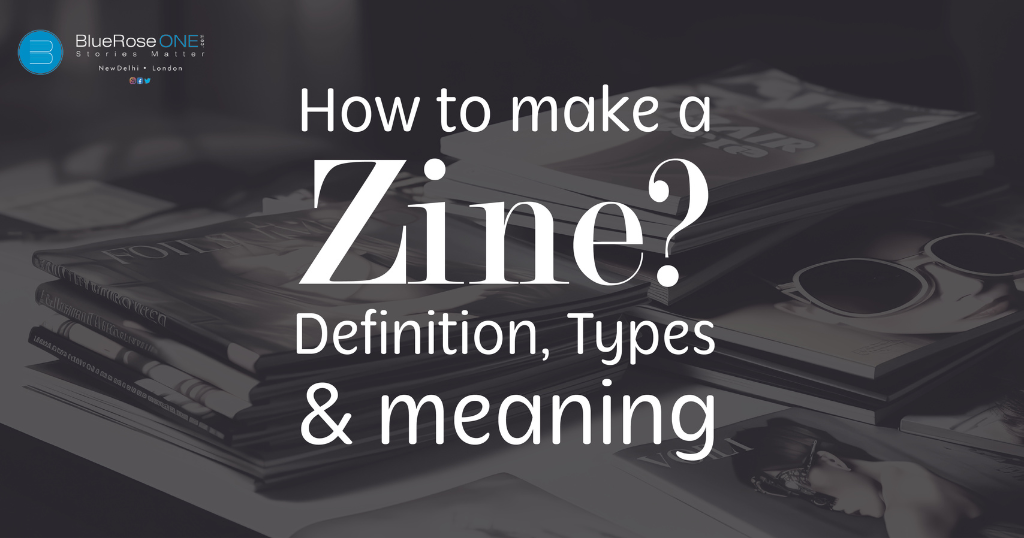In a world dominated by digital media, zines offer a refreshing analog twist on self-expression. They are DIY publications, often small and independently crafted, that have been a beloved form of underground art and communication for decades.
Read: Short Stories Promotion: How to Promote Your Short Stories on Medium?
If you’re curious about how to make a zine, what zines stand for, or the different types, you’ve come to the right place. This blog will be your guide to the wonderful world of zine-making.
What does Zine stand for?
Understanding the Term “Zine”
The term “zine” is derived from “magazine” or “fanzine.” Zines are typically small, self-published booklets or pamphlets, and they cover a wide range of topics, from personal stories to art, politics, and pop culture. Zines are often a platform for marginalised voices, allowing creators to share their thoughts and passions without the constraints of traditional publishing.
What Is Needed to Make a Zine?
Essential Supplies for Zine-Making
Zine-making is a creative and accessible form of self-expression, and one of its charms is that you don’t need a vast array of expensive tools to get started. Here are the essential supplies you’ll need to make a zine, along with some examples and tips on how to use them effectively.
- Paper:
Paper serves as the canvas for your zine, the medium on which you’ll put your thoughts, stories, and artwork. Common choices for zine paper include standard printer paper and coloured or textured paper for added visual appeal.
Example: For a personal zine documenting a road trip, you might use a mix of standard white paper for text and high-quality, textured paper for photographs to enhance the tactile and visual experience. - Scissors:
Scissors are your trusted cutting tools for shaping paper to the desired size and trimming edges. You’ll use them to cut your pages and create the final shape of your zine.
Example: Let’s say you’ve created a zine about urban gardening. You can use scissors to precisely cut out photos of your thriving garden, ensuring they fit neatly on the pages of your zine. - Glue or Tape:
These are used to bind the pages together. Glue sticks and double-sided tape work well, providing a secure way to assemble your zine. This step helps give your zine a polished and professional appearance.
Example: When making a zine featuring your collection of favourite poems, you’ll use double-sided tape to attach printed verses neatly onto the pages, creating a clean and cohesive presentation. - Writing and Drawing Tools:
Pens, pencils, markers, and other drawing and writing tools are essential for adding text and illustrations to your zine. These tools allow you to personalise your zine with your unique handwriting and artistic style.
Example: If your zine is a reflection of your personal experiences, you might use a mix of pens and markers to add handwritten captions and illustrate scenes from your life. - Imagination:
Your imagination is the most critical element in zine-making. Zines are a platform for self-expression, so your unique ideas and creativity are what make your zine truly one-of-a-kind. Don’t be afraid to think outside the box, experiment with different styles, and let your imagination run wild.
Example: If you’re passionate about a particular social issue, your zine might include hand-drawn infographics, personal anecdotes, and powerful words that aim to inspire others to take action.
Tips for Getting Started:
- Keep it simple: Don’t feel pressured to invest in fancy art supplies. You can create an engaging zine with basic materials. It’s about your message and creativity, not the tools.
- Personalise your zine: Your zine should reflect your unique perspective and personality. Use your handwriting, draw your own illustrations, and infuse your zine with your voice.
- Experiment: Zine-making is an art form where experimentation is encouraged. Try different paper types, fonts, and illustration styles to find what best fits your project.
- Connect with the zine community: Engaging with other zine-makers can be inspiring and informative. Joining zine fairs, forums, or social media groups can provide valuable insights and opportunities for collaboration.
- Don’t overthink it: There are no strict rules in zine-making. Let your creativity flow and enjoy the process. Your zine can be as unique and unconventional as you are
How many pages is a zine?
Page Count in Zines
The number of pages in a zine can vary widely, but they are typically quite short. Zines can range from a single sheet folded into a small booklet (making a total of 8 pages when folded correctly) to more substantial zines with 16 pages or more. The beauty of zines is their flexibility; you decide how much content you want to include.
How to Make a Zine Step by Step
Creating Your Zine
Zine-making is a highly creative and personal endeavor. To make your zine, follow these step-by-step instructions, which will take you from brainstorming your theme to sharing your creation with the world. Each step is an opportunity for you to infuse your unique style and perspective into your zine.
- Choose Your Theme:
The first step in zine-making is selecting a theme. Decide what your zine will be about. It can be as personal as a diary, a collection of poems, a mini-comic, or anything else that inspires you. The theme is the backbone of your zine, and it’s the canvas on which you’ll paint your creative vision.
Example: Let’s say your chosen theme is “Everyday Adventures.” Your zine could be a compilation of daily observations, small victories, and little joys that often go unnoticed but hold significance in your life. - Prepare content:
With your theme in mind, it’s time to create the content for your zine. Write, draw, or use any medium that resonates with you to produce the content. The key here is to be authentic and let your creativity flow. This is your opportunity to share your stories, thoughts, and artwork.
Example: If your zine is focused on “Everyday Adventures,” you might include written vignettes, sketches, or photographs of everyday moments that have made a lasting impression on you. - Layout:
Determine the layout and order of your pages. Consider how the text and images will interact to create a cohesive narrative. The layout sets the visual tone of your zine and guides readers through your content.
Example: To maintain a casual and diary-like feel in your “Everyday Adventures” zine, you could opt for a loose, hand-drawn layout. Irregularly shaped frames for illustrations and a mix of fonts can contribute to an authentic and personal touch. - Design the cover:
The cover of your zine is its first impression, so it should reflect the theme and content inside. Add a title, some artwork, or a simple design that captures the essence of your zine and entices readers to explore further.
Example: For your “Everyday Adventures” zine, you could design a cover featuring a hand-drawn image of a daily scene, like a cup of coffee, accompanied by a handwritten title. This provides a preview of what readers can expect inside. - Print and assemble:
With your content ready and your cover designed, it’s time to print your pages. After printing, cut them to the desired size. You’ll need to arrange the pages in the order you want, which will depend on your layout.
Example: For a small zine, like a minizine, you may choose to print two pages on one side of a single sheet and then fold it in half. This technique creates a tiny booklet, and you can place these in the correct order to maintain your story’s flow. - Bind Your Zine:
Use glue or tape to bind the folded pages together. Ensure that the binding is secure so that your zine remains intact and readable. This step gives your zine its finished, professional appearance.
Example: Apply a thin layer of glue to the folded edges of your pages and press them together. Place something heavy on top, like a stack of books, to ensure the pages adhere well. This approach is ideal for securing a zine’s pages. - Personalise:
Add any final touches to your zine that enhance its uniqueness. This could involve hand-drawn details, stickers, or additional artwork that makes your zine even more personal and visually appealing.
Example: If your zine on “Everyday Adventures” includes sketches of everyday objects, you might personalise each copy by adding a small, unique doodle in the margins. - Share Your Zine:
Your zine is now ready to share with the world. Share it with friends, distribute it at zine fairs, or even sell it online. Zines are meant to be shared and enjoyed, so don’t be shy about putting your creation out there.
Example: You can host a zine release event at a local artsy café, where you display your zine and talk about your creative process. Sharing your zine can help you connect with like-minded individuals and create a community of zine enthusiasts.
Zines are a unique and cherished form of self-expression, allowing creators to share their thoughts, art, and stories in an accessible, DIY format. Whether you’re a seasoned zine-maker or a complete beginner, the world of zine-making is open to all who want to explore and share their creativity.
Read: A Complete Guide: How to Make Your Book an International Bestseller in Global Market
So, gather your supplies, let your imagination run wild, and start crafting your own zine. It’s a journey of self-discovery, storytelling, and artistry that’s truly one-of-a-kind.
















